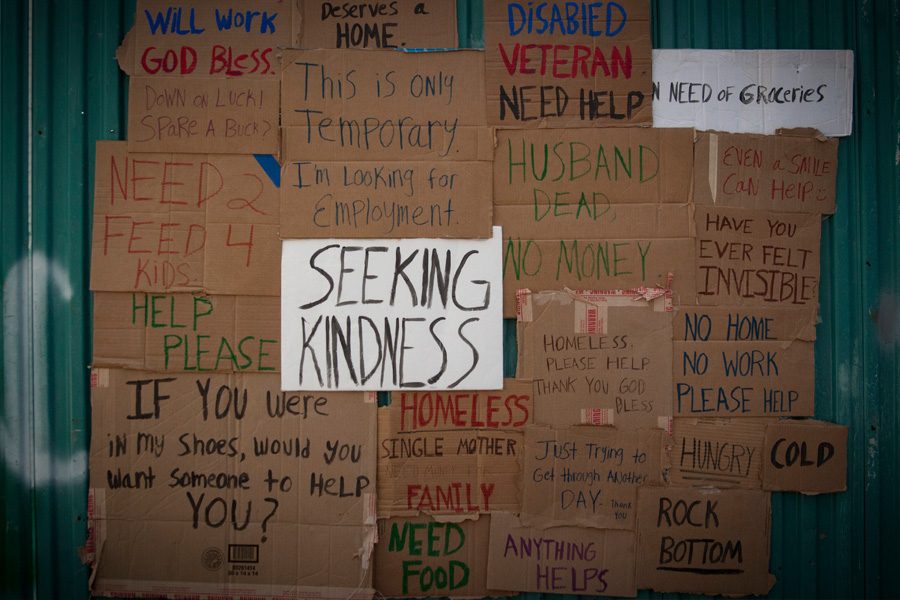Reality of Poverty
In-depth look at the effects of economic distress in America
A collection of cardboard signs that identify some of the struggles of living poverty.
March 29, 2017
Poverty is an ongoing, urgent matter in the U.S. that has been affecting millions of Americans for more than three decades. Those millions of Americans are not nameless, faceless, individuals that only make up a statistic, they are real people experiencing the reality of poverty. Children make up a significant portion of the millions affected by poverty in the U.S.
Defining Destitution
In the United States, poverty is determined by the amount of money an individual makes annually and their location above or below the “poverty line,” an estimated income level capable of securing life necessities such as food and water, clothing and shelter. The 2015 U.S. Census Data found that, by race, African Americans make up 24.1 percent of poverty in America, followed by 21.4 percent Hispanics, 11.4 percent Asians, and 9 percent whites.
“Measuring poverty based off of how much an individual makes relative to the rest to the nation is reasonable, but living standards fluctuate [from] state to state,” sophomore Adrian Sepulveda said. “If it is difficult or impossible for someone to afford essential needs for themselves and their family, they are in poverty, and this statistic aids the government by calculating the severity of poverty throughout the nation.”
A family of four with a yearly income of $24,250 would be considered below the poverty line, according to the U.S. Department of Health & Human Services.
“Family income is a key factor in healthy child development,” sophomore Jaelen Lou Sandoval said. “If they don’t get the security and resources [they need], it can be harder to get out of poverty.”
America needs to take action in the education and bringing up of our youth since they are the future of our nation.
— Elene Thomas
Freshman Savannah Martinez said although there are multiple causes of poverty, a lack of education is the main reason people to find themselves suffering from financial instability.
“If people are not educated, they are incapable of holding a high-paying job and can not make a lot of money,” senior Kaleb Wier said. “Another factor that causes Americans to refrain from pursuing a good education is not being able to afford a college education.”
The Pew Research Center found that 21.8 percent of Americans in poverty were below 18-years-old, while 9.1 percent of Americans in poverty were over 65-years-old.
“It’s quite upsetting to see more children than senior citizens in poverty,” sophomore Elene Thomas said. “Our country is constantly striving to be the best, yet a large amount of children are living in unsustainable conditions. This indicates that America needs to take action in the education and bringing up of our youth since they are the future of our nation.”
According to a study from the Urban Institute, almost 40 percent of children in America experience at least one year living in poverty before they turn 18. Children in poverty are 13 percent less likely to complete high school and 43 percent less likely to obtain a college education.
“People that live in poverty are statistically less educated, therefore are not qualified to get careers that pay higher wages or salaries,” world geography teacher Sarah Johnson said. “Students that live in areas of high poverty are restricted to public education because of the inability to pay for private education. Public education is funded by money coming from the community. If the community is poor, there are less taxes to collect for the school districts. [This can cause] schools to be underfunded and not provide the same education that a student living in an affluent area would receive.”
Reformation & Education
Although people living in poverty are linked to increased substance abuse and higher incarceration rates, they are also associated with the equal opportunity to obtain a quality education with government assistance, according to the Center for American Progress.
“People in poverty are more likely to be [substance abusers] and sent to prison because they feel as if there are no other options for them in the surroundings they live in,” sophomore Braelynd Paruszewski said. “Education alone can not save someone from poverty, but it is a start.”
A study conducted by the National Bureau of Economic Research found that there was a positive correlation between poverty and substance abuse with drugs like marijuana and cocaine, while researchers from Duke University found that “economically stressed” children experienced higher rates of tobacco usage later in life.
“Any positive correlation between substance abuse and poverty indicates the growing need to rehabilitate a dependent demographic,” Sepulveda said. “Legalizing more substances and building more rehabilitation centers and programs will increase welfare while reducing substance abuse in America.”
One fourth of the world’s prisoners are located in American facilities, and there are an estimated 2.7 million children in the U.S. with one incarcerated parent, according to RaisingOfAmerica.org and the Boston University School of Public Health.
Education alone can not save someone from poverty, but it is a start.
— Braelynd Paruszewski
“If a student living in poverty [lives in an impoverished] area and goes to school with others in the same situation, he or she is more likely to engage in dangerous criminal activity like joining gangs, selling drugs and weapons and prostitution to earn money,” Johnson said. “Students in poverty face more psychological and physical problems than students that come from a household with more financial security because they are prone to ridicule from other students and their self-worth is diminished, leading to larger and more complex psychological problems that will carry that person around their entire life. This is a cyclical pattern that leads to an unhealthy lifestyle, and little, if any, medical care for prevention of disease.”
While living in poverty can cause obstacles for American students, the government has made some efforts to help those who struggle to obtain a complete education, including the No Child Left Behind Act. This bill was passed in 2002, “closes student achievement gaps” and gives American students “a fair, equal and significant opportunity to obtain a high-quality education,” according to the Office of Superintendent of Public Instruction.
“I think it is great that America is trying to improve its education system,” freshman Chloe Snider said. “This improvement will better Americans by allowing them to get better paying jobs.”
The advancement of the American education system can lead to an increase in the number of citizens readily available to enter the workforce, but also causes federal underfunding due to the government having to invest in every school in the country, according to ConnectUSFund.org.
“If improvements in the education of our country occurred, this would allow more teens to willingly continue through years of schooling and allow them to obtain a high school diploma in their future,” Thomas said. “This can open a large amount of job openings for students to work [towards], and could possibly help them begin to pay for future college expenses if they want to gain a higher education, and in return, a higher paying job. If every teenager in the high schools across the nation who were not originally desiring to finish high school followed a path similar to this, there could possibly be a decrease in poverty in America.”
Ending Poverty
According to the Borgen Project, the economic growth of a country is guaranteed if the entire population can be educated, and if America can invest in its schools, there would likely be a decrease in the country’s poverty rate.
“The best way to reduce poverty is through rehabilitation and increased funding towards the public education system,” Sepulveda said. “A higher percent of skilled workers in the workforce will benefit every economic role of society by an [increase in productivity.]”
Sophomore Sujay Bhojaraju said that people who live in poverty are more likely to be sent to prison because they live in areas with higher crime rates and criminal activity, and those who have been to prison “face many struggles coming back into society.”
“Individuals who have been previously incarcerated are given the stereotype that they are untrustworthy and likely to commit [another] crime,” sophomore Lysandra Pecina said. “There is no way to get [employers] to look past a person’s record other than changing their view, but it should be known that former convicts are genuinely working towards self-improvement. When there are few jobs available, it’s hard for them to get back on their own two feet, but [former convicts] can achieve so much if they are given the chance to reenter society.”
The current minimum wage in the U.S. is $7.25 an hour, but if that value is raised to $10.10 an hour, then 20 percent of American children would benefit from a higher minimum wage because their families would be able to move away from the poverty line and better support themselves with a larger income, according to RaisingOfAmerica.org. However, the United States Department of Labor reported that raising the minimum wage to $10.10 an hour could cause a slight inflation, but it would not be significant enough to damage the economy.
“Those who struggle to make money constantly and pay for their family’s health and well-being will hopefully be able to find a light now that the government is starting to really take action in the care of those who cannot fully provide for their needs,” Thomas said. “The existence of poverty in America is something that should have been taken care of many years ago. It is a topic in which our country needs to fully address and our people need to come together to help out those families that live just around the corners of our own community.”








